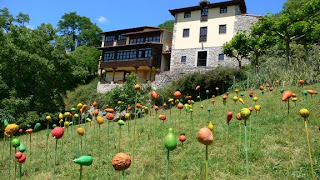Summer officially arrived this week and with it a spell of hot weather with temperatures over the 30’s. The warm weather means there is a lot to harvest in the vegetable garden and it also means there is a lot of watering to do.

Garlic drying in the warm weather
This year we are doing more trials in the vegetable gardens particularly variety trials and planting date trials. The information we gain, which varieties are most suited to our conditions and the optimum planting times helps us to continually improve our cropping systems, which basically means bigger, better and more reliable yields.

Courgettes, courgettes and more courgettes.
The greenhouse we built last autumn has come into its own; amongst other things allowing us to produce the different plants and varieties necessary for the trials we’ve been conducting. It has also meant we have been able to sow earlier and produce larger plants which we planted outside when the warm weather came. The idea of using larger plants at planting time is to start harvesting earlier, and we’ve just started picking our first peppers which reflects the success of this system.

Large plants ready to plant out.
We are now picking a wide range of crops including; sugar peas, french beans, fennel, cabbage, calabrese, romanesque, lettuce of all shapes and colours, leafbeet, beetroot, carrots courgette and more. Also for the first time we have an excellent crop of cherry tomatoes coming from the greenhouse and we’re now picking well over 1 kg of fruit every day. Here we have two varieties a red and orange variety, both selected for their flavour which is outstanding.
Although we call the ”huerta” our vegetable garden it’s also where we produce our soft fruit and this year there’s an abundance of all sorts of berries including; strawberries, raspberries, blackberries, tayberries, boysen berries and blackcurrants. The hotel restaurant hasn’t been able to keep up with the influx of fruit even though there have been three or four different types of soft fruits desserts on offer each night. I often wonder what we would do without deep freezers to soak up the excess berries.
There are still a lot of different vegetables growing in the garden which we haven’t started harvesting yet such as cucumbers, pumpkins and aubergines, but it won’t be long before we start. And although the vegetable garden is full of crops waiting to be harvested like nature we can’t be complacent and we have to be preparing for the coming seasons; autumn, winter and spring. So we now we are preparing young plants for crops such as autumn and winter cabbage or purple sprouting to crop in February and March. We are also making the last sowings of French beans for September and October harvest as well as sowing beetroot for harvesting throughout the winter.

Preparing plants for autumn and winter cropping.
Finally we shouldn’t forget the essence of life; seeds, so important and yet so often taken for granted. We try to produce seed from some of the different crops and varieties we grow. Priority is given to saving and maintaining varieties which are of local origin such as our land race of onions which we estimate has been kept in this area for over 40 years. When saving seed we select the healthiest plants with the characteristics we consider interesting and then let them “go to seed.” So it’s quite common to walk round our vegetable garden and see a large plant often looking rather out of place. These are the plants we have chosen for harvesting seed and if only in a small symbolic way help keep seeds in the hands of farmers and small communities where they belong.
Saving seed; leek flower heads.


























